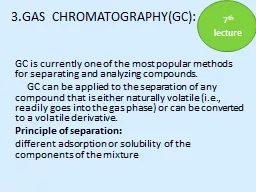

GC is currently one of the most popular methods for separating and analyzing compounds GC can be applied to the separation of any compound that is either naturally volatile ie readily goes into the gas phase or can be converted to a volatile derivative ID: 781466
Download The PPT/PDF document "3.GAS CHROMATOGRAPHY(GC):" is the property of its rightful owner. Permission is granted to download and print the materials on this web site for personal, non-commercial use only, and to display it on your personal computer provided you do not modify the materials and that you retain all copyright notices contained in the materials. By downloading content from our website, you accept the terms of this agreement.
Slide1
3.GAS CHROMATOGRAPHY(GC):
GC is currently one of the most popular methods for separating and analyzing compounds. GC can be applied to the separation of any compound that is either naturally volatile (i.e., readily goes into the gas phase) or can be converted to a volatile derivative.Principle of separation:different adsorption or solubility of the components of the mixture
7
th
lecture
Slide2Stationary phase:
adsorbent (GSC)or wetted carrier material(adsorbent coated by a liquid layer)( GLC )Liquid layer: non-volatile liquids, macromolecular productsA simple GC system consists of: 1. Gas source (with pressure and flow regulators)2. Injector or sample application system (sample inlet)3. Chromatographic column (with oven for temperature control)4. Detector 5. computer or recorder
Slide3There are two main types of columns
used in GC:1-Packed columnslarge sample capacity preparative work 2-Capillary (open-tubular) columns higher efficiency smaller sample size analytical applications
Slide4Carrier gas: He (common), N2, H2
(MUST BE INERT) Flow = 25-150 mL/min packed column Flow = 1-25 mL/min open tubular columnOven: 0-400 °C ( average boiling point of sample)common adsorbents include:• alumina • silica • active carbon
Slide5Slide64.AFFINITY CHROMATOGRAPHY
The principle of affinity chromatography is that the stationary phase consists of a support medium (e.g. cellulose beads) on which the substrate has been bound covalently.As the mixture of proteins is passed through the chromatography column, those proteins that have a binding site for the immobilised substrate will bind to the stationary phase, while all other proteins will be eluted in the void volume of the column.
Slide7Slide8A protein mixture in a suitable buffer solution is passed down the column and a protein with sufficient affinity for the bound ligands is retarded and may later be eluted in a purified state by a change in ionic strength Or PH of the column
buffer.Ligands such as amino , hydroxyl, carbonyl and thio groups located to serve as ligand binding sites. The ligand/ molecule can be dissociated by changing the PH
Slide9Uses :
-production of vaccines.-Nucleic acid purification in genetic engineering.-Separation of enzymes and proteins.Advantages:1-high specifity2-high degree of purityDisadvantages :1-expensive ligands2-leakage of ligands
3-relatively low productivity
4-degradation of the solid support
Slide105.ION EXCHANGE CHROMATOGRAPHY:
The most popular method for the purification of proteins and other charged molecules is ion exchange chromatography. In cation exchange chromatography positively charged molecules are attracted to a negatively charged solid support. Conversely, in anion exchange chromatography, negatively charged molecules are attracted to a positively charged solid support.
Slide11Mechanism
To optimize binding of all charged molecules, the mobile phase is generally a low to medium conductivity (i.e., low to medium salt concentration) solution. The adsorption of the molecules to the solid support is driven by the ionic interaction between the oppositely charged ionic groups in the sample molecule and in the functional ligand on the support. The strength of the interaction is determined by the number and location of the charges on the molecule and on the functional group. By increasing the salt concentration (generally by using a linear salt gradient) the molecules with the weakest ionic interactions start to elute from the column first.
Slide126.ELECTROPHORESIS : Electrophoresis may be the main technique for molecular separation in today's cell biology laboratory. Because it is such a powerful technique, and yet reasonably easy and inexpensive, it has become common . Electrophoresis can be one dimensional (i.e. one plane of separation) or two dimensional.
Slide13Slide14One dimensional electrophoresis is used for most routine protein and nucleic acid separations. Two dimensional separation of proteins is used for finger printing
. Electrophoresis is a method for separation and analysis of macromolecules (DNA, RNA and proteins) and their fragments, based on their size and charge.
Slide15It is used in clinical chemistry to separate proteins by charge and/or size and in biochemistry and molecular biology to separate a mixed population of DNA and RNA fragments by length, to estimate the size of DNA and RNA fragments or to separate proteins by charge.
Slide16Nucleic acid molecules are separated by applying an electric field to move the negatively charged molecules through a matrix of
agarose or other substances. Shorter molecules move faster and migrate farther than longer ones because shorter molecules migrate more easily through the pores of the gel. This phenomenon is called (sieving). Proteins are separated by charge in agarose because the pores of the gel are too large to sieve proteins.